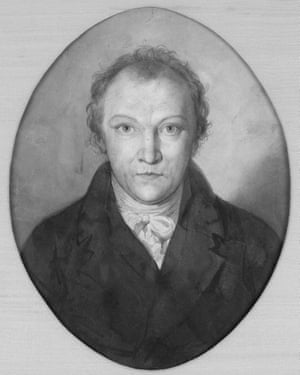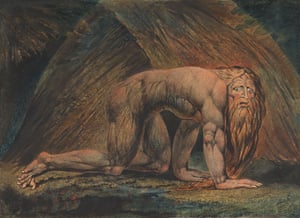[ad_1]
This stupendous show opens with a starburst: the naked figure of Albion rising in glory, rainbows exploding around his outstretched arms. It is a curtain-raiser, a full frontal performance: the beautiful dancer in mid-sashay on the edge of a cliff, bringing light to dispel the darkness. And Albion’s arms are holding out for more – welcoming this new dawn, inviting us all to rise up with him. It is the great wake-up call of British art.
But what does it mean, this spectacular engraving? Albion represents England (and primeval man) in the made-up mythologies of William Blake (1757-1827). But many people believe this is not Albion so much as the personification of freedom, imagination, independence. Shake off those mind-forg’d manacles, rebel against conservatism, slavery, organised religion, even tight clothes: interpretations of the image are ceaselessly at odds.
Everyone knows that Blake is art’s original free spirit. He is against science, the establishment, the Age of Reason. Yet this radiant figure might be the very emblem of Enlightenment thinking, just as it could be the angel Gabriel, a prelapsarian Lucifer, or the spirit of political awakening.
The curators of this colossal survey, the first on such a scale in nearly 20 years, are wise to point out the almost impenetrable complexities of Blake’s thinking from the start. Their aim is to throw the focus on his works as images, as opposed to emblems – tiny, teeming visions of gods, monsters and wild scenarios taking place at the bottom of the ocean or outer space, but above all in the free world of Blake’s imagination.

He is rightly presented here as the most radical of leftfield artists. The son of a Soho shopkeeper who stumped up the money for drawing lessons and his son’s apprenticeship to an engraver at 14, Blake studied for about a year at the Royal Academy. He learned to loathe the conformism of both the institution and its president, Joshua Reynolds. There was only one show – an unqualified disaster held above the Soho shop, with not a work sold. All his life, Blake kept having to make engravings of other people’s art.
Except for the occasional hint of a Regency sideburn, however, his art reflects nothing of Georgian London. An unconfirmed self-portrait in the first gallery shows the artist with an intense but entirely in-turned gaze, plus that same startling symmetry that characterises so much of his work; images stream out of his mind, not in through his eyes. The critic of Blake’s one and only show – an unqualified disaster, held above the shop – thought he was eccentric, not to say mad.

And Blake’s art remains irreducibly strange. Familiarity cannot diminish the utter singularity of his home-grown aesthetic: heads floating on columns of transparent Lycra-like material, rippling up towards multicoloured skies or gathering in tumultuous spirals. Saints diving through the firmament, devils flickering like fire, angels back-crawling through transparent seas. Lone bodies are shown in convulsion, drowning, paralysed or hunched tight as padlocks. Unbound, they appear spreadeagled, levitating, or hurtling upwards like the bellowed flames up a chimney.
Moses holds up the tablets: a rocket man just about to lift off. Adam and Eve, with their high waists and Blake’s weirdly pronounced muscle groups, perform a nude pas de deux. Men and women look alike, and both at times resemble a stylised version of his self-portrait, with its fixated eyes. Tulips make love, lovers couple inside flowers, fleas are reincarnated as titans. Newton does his pointless calculations – as if the world could possibly be measured – at the bottom of an inky blue sea.
Could anyone, without benefit of scholarship, honestly interpret that marvellous icon as a diatribe against Newton and all his works? Can anyone really tell the difference between Blake’s The Ancient of Days, with his wind-blown beard and lightning-bolt dividers, and his doppelganger in the imaginary The Book of Urizen, representative of science and unfreedom? These visual archetypes appear interchangeable, evenly distributed across the moral spectrum. And walking through this immense show – 300 works and more – it becomes obvious that good and evil may well have the same face or physique in Blake’s conceit. After all, Lucifer eventually becomes Satan.
In his visions, the devil may be tragic, tortured by interminable regret; and God may be violent, uprooting Adam like a weed from the earth. Horror is not always frightening. One illustration of hell shows a smoking serpent front of stage in a kind of glamorous limelight. Cerberus has at least one head resembling a London dog.

This late ink and watercolour painting is unusually large for Blake, about the size of a hardback book. In the early years, his paintings looked like outsize black and white prints, scenes from the Bible done in greyscale, all hieratic poses, super-long bodies and neo-Gothic drapes, based on his fascination with Queen Eleanor’s medieval tomb in Westminster Abbey. But quite soon they shrink in size, even as they expand pictorially; to paraphrase Blake: infinity in the palm of your hand.
Ideas proliferate as images. A wild scrimmage of monkeys: evolution condensed. Infants so joyful they hover in the air like butterflies. Urizen falls to earth like a comet, a diver, or an Olympic gymnast balanced head down on a beam. God, in one supreme vision, is shown creating the entire world in the act of opening the pages of an illustrated book.
Nobody made books like William Blake. He pioneered the technique of relief etching, in which everything but his images and words – which had to be written backwards – was corroded from the plate. The words appear in his own handwriting; the images are hand-touched by Blake, and also by Catherine, so that they look like individual watercolours. Working this way, Blake freed himself and his art from traditional printing and existing typefaces.

In displaying them bound up as printed books, as well as separately, in the individual sheets prized by museums all over the world, the curators emphasise Blake’s unique enterprise on paper. Everything he imagined – radiant planets, swooping angels, infernal pile-ups – was choreographed in terms of the illuminated page. Scenes float like vignettes – a star-spangled heaven top right, the lamb of God lying down bottom left – or merge with the words themselves, passing through them like the very things depicted: rivers, fireballs, gusting winds.
Sometimes the script is so tiny it is almost illegible, particularly when there is so much going on between the lines. It is astonishing to spot proper names like Washington and Tom Paine on a page, in the poem America, beneath a dazzling image of Urizen lying back on an armchair composed of storm clouds. And while the words are an indelible exhortation to freedom in themselves – freedom from slavery, or British rule, freedom from conventional marriage or dark Satanic mills – the images carry that idea of liberty as a graphic principle.
Blake may depict Apollo dancing like a prima ballerina, or Death taking a bow. The Symbolic Figure of the Course of Human History Described by Virgil is – amazingly – a dead ringer for the Statue of Liberty, complete with spiky diadem and torch. It is impossible to believe that Frédéric-Auguste Bartholdi hadn’t seen Blake’s watercolour when he designed his monument.
Every figure must fit the page – sometimes deliberately fighting its limitations, in the case of the eternal prophet Los, howling in despair against the imprisoning walls of his box. But the page is also the source of true freedom. Everything can go wild within the fierce symmetry of Blake’s art – man becomes Superman, angels are skydivers, gods and prophets are shape-shifting wraiths and every sinew is visible beneath those see-through garments because everything is vision transcribed; figments of line and wash on the airy page.
Peering into these tiny pictures, you keep seeing premonitions of our present times: factionalism, violence, stupidity, oppression. But it would be hard to think of a more encouraging artist; and that is a matter of images, beyond words. Blake’s figures are designed to inspire: urging you to stand up, rise up, embrace your fellow man and woman with their surging uplift, distilled in Albion rising. His whole being was devoted to freedom, his art a perpetual call to arms.
•William Blake is at Tate Britain, London SW1 until 2 February
Three stars of the Blake show

Nebuchadnezzar 1795-1805
The king of Babylon is a terrible warning to us all: “those that walk in pride, the Lord can abase”. Blake’s Nebuchadnezzar has been so abased it is by now a hybrid of man and beast, crawling the Earth on his hands and knees, skin like hide, toes turning into griffin’s talons.
The Ancient of Days 1827
The divine white-beard, reaching down from his burning disc to measure the Earth below with his shining dividers. For all the force and similarity, this is not in fact God but Blake’s Urizen, the despised personification of Reason and Science.
The River of Life 1805
A family streams up the transparent waters of this winding river, hand in hand, past classical buildings and towards a shining golden sun. Everything flows onwards towards the light, in one of Blake’s most radiant visions of happiness. LC
[ad_2]
READ SOURCE


